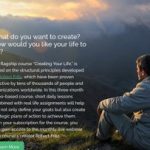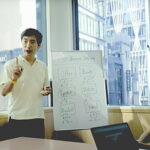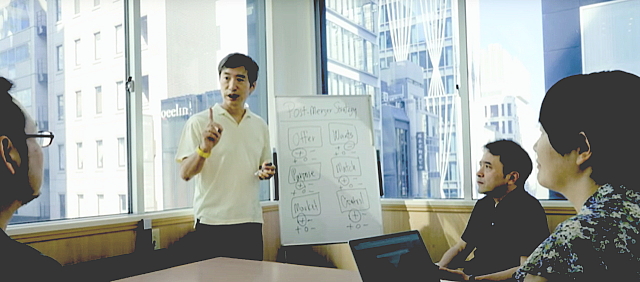The other day I was checking out at our local Food Coop. The lady in front of me asked, “Are you Robert Fritz?” “Yes.” “You’ve changed my life.” “How did I do that?” “I took one of your courses 20 years ago, and it has completely changed the direction of my life.”
Actually, it is not unusual for people to tell me such wonderful things. I never get tired of it, nor do I ever take it for granted. In fact, all of the workshops and programs I’ve created have the goal of enabling people to create the lives they want to live.
Of course, lots of programs promise to change your life. And those who participate in these courses are always well intentioned. I think the promise self-help makes is too often based on some basic misunderstanding of what creates real and lasting change. The usual premise is this: things will work out if you change your attitude and beliefs. Some think that you need to resolve your past to move on to your future. Some are promoting magical thinking, that thought is creative, and if you think the right things, the law of attraction will bring you riches and fame. Most of these approaches are old wine in new bottles, claiming to have the latest approach to life’s great secrets.
I thought the same way about 40 years ago. My first courses were based on these ideas. At first, almost everyone created their goals. But then, as I tracked these students over time, I found a very strange thing. Over time, many of these same people had reversals, and they had lost the progress they had made. I began to track the patterns and discovered there were two basic ones: oscillation and advancement.
My question became what caused the difference? This question led to the discovery of structural dynamics. The basic understanding: the underlying structure of anything will determine its behavior. No matter what your attitude, how positive your thoughts, how many affirmations you make, how many repressed areas of consciousness you relive and release, how much will power you try to assert, how much you meditate, if the underlying structure of your life doesn’t change, your progress will be reversed. You will end up in the same place you started. It’s structure and structure is physics.
This discovery was truly revolutionary. It presented a completely different understanding of why people do what they do. It was other than psychology, metaphysics, psychotherapy, and the other theories that were popular. From these discoveries, I began to develop just how to change one’s underlying structure, which I first wrote about in 1984 with the first edition of The Path of Least Resistance, which became an international best seller. According to Amazon, that and later editions of the book have influenced over 100 other books.
About 10 years ago, we began to work with a company that presented the first video based version of Creating Your Life. Later, my son Ivan Fritz and his wife Jen formed a new company and I designed a new generation of the course and we shot over 120 videos. The first version, only available for iPads. was an Apple App. Ivan and Jen have now updated the course, creating an internet based format, available for all computers, tablets, and smart phones.
What is special about this course is that it accomplishes something well beyond goal setting and forming good productive habits. It changes your orientation by changing the underlying structures of your life. This is not a small matter. In fact, from the design of the course, and over enough time to assimilate the principles being taught, real and lasting change can happen in your life-building process.
Creating Your Life is being used as part of a program to enable Special Operations Forces, such as Navy Seals, to successfully transition to civilian life. And now, it is available to you.
The course has two learning strategies. One is the daily lessons that last from a few minutes up to twenty minutes. This is the learning dimension. The other strategy is the living dimension, where you apply that day’s lesson in your life. For over 90 days, the power of the creative process builds in your life experiences.
Little by little, you are able to shift from, what in The Path of Least Resistance I describe as the reactive-responsive orientation, to the generative-creative orientation. Your life becomes the subject matter of your own creative process.
From Ivan Fritz:
It’s a new year and a new decade. Many of us see the New Year as a great time to begin new projects, set new goals, and to rethink our lives and our direction. If you could have the life you’d choose, what would it be?
Now announcing “Creating Your Life” for the web, our three-month, self-study course with Robert Fritz that helps you not only define your goals but also create strategic plans of action to achieve them. You’ll be taken on a journey that starts with small, easy to achieve goals and moves you over time to long term, more complex goals while building daily habits, changing how you think about your objectives, and building the discipline you’ll need to accomplish those things that matter most to you!
The new version of the course runs on any device with a web browser, so you can take it with you wherever you go. You’ll also be supported on your journey by participating in our monthly “Conversations with Robert,” where you get the chance to interact with Robert directly as well as other students taking the course. Join us today and start your own journey!
Scroll down in this email to see what features are included with your subscription, the cost per month, and how to subscribe.
Also, please feel free to contact us directly at info@creatortools.net with any questions, or check out our FAQ or our course page for more information. Thank You and Best Wishes for a Happy 2020!
Ivan Fritz – President CreatorTools, Inc.
What’s included with your “Creating Your Life” subscription:
• “Creating Your Life,” a three-month video based self-study course with Robert Fritz, which helps you develop the practical skills you need to systematically create the life you want to live. Daily lessons start you off with small, easy-to-take steps and slowly builds you up to larger, longer-term goals. By the end of the course, you will have a plan for the next 5 years and beyond. Please visit our website for more information.
• “Conversations with Robert” webinar: Once a month, active students from all around the world gather online to talk directly to Robert about the principles and practices you’ll be learning.
• Unlimited support along your journey via email and phone when needed.
FIND OUT MORE:
https://www.creatortools.net/subscribe/













